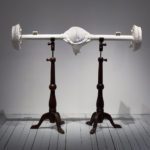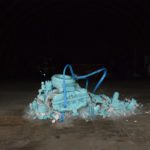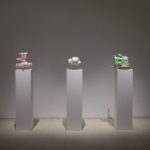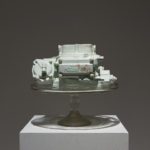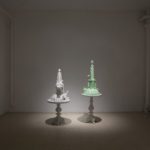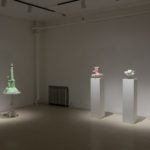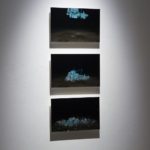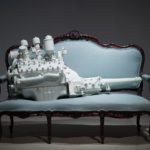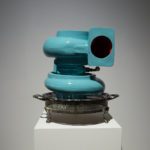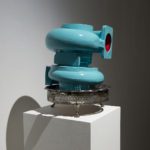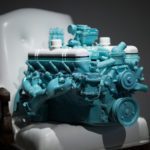Opening reception: Saturday, May 6, 2017 from 3-5 p.m.
Clint Neufeld
Art Mûr, Montreal (QC)
Text by Martha Robinson
The title of Clint Neufeld’s ceramic incarnation of a Detroit diesel engine, Screaming Jimmy, the first time we met in that field I knew you were the one (2016), now in the collection of the Remai Modern, speaks volumes. That a diesel engine should have a nickname—Screaming Jimmy—is emblematic of the artist’s practice of using objects that come with baggage, with their own histories; and too, it references the stories Neufeld finds reflected back at him, an anthropology by engine. The title also chronicles Neufeld’s first compelling encounter with the (real) Detroit diesel, what the artist describes as something not more complicated than a recognition of beauty, and a desire to share with others the rethinking of the engine as aesthetic object.
Neufeld’s work can be addressed conceptually—perhaps through Thing Theory, as an object “with a changed relation to the human subject,” resembling something that works, or worked, and now an object asserting itself as thing.1 The recontextualization of the object and its attendant meanings is what the artist interrogates, “different people’s understanding of the same thing.” As objects of someone else’s history, the ceramic engines become a common language to engage viewer and artist—catalysts for stories, collected histories. Neufeld’s understanding of his practice has grown through the layered histories his engines gather, conversations which have led him to what, in turn, he wishes to question more specifically in his practice.
Neufeld’s statement that he “just wanted to make a really shiny engine,” belies the careful juxtaposition of object and surface that transform his motors and engines into fragile objects. Merging the visual identity of fine china, its inherent delicacy, with engines or lathes, Neufeld remarks he didn’t know that he “was aware of what the implications would be.” Screaming Jimmy is graced with colours recalling vintage domestic china; satin lathe (2014) and satin valve grinder (2015) take as their inspiration the matte finish and relief decorations of Wedgewood’s iconic Jasperware; one yellow rose (2012) doubles the historical implications of Neufeld’s work, the delicate transferware decals of its massive engine disputing its own identity as it rests lightly on a Queen Anne sofa.
Smash (2016), the video accompanying this exhibition, underscores these juxtapositions: playing on the implicit fragility of fine china confronting the perceived mass of an engine, a motor, a lathe. Hoisted much as its real-life counterpart would be for installation in a chassis, the ceramic engine—almost the twin of the engine seen in one yellow rose—drops, immediately and literally shattering the solidity that the viewer attaches to it, disrupting our understanding of the aestheticized object to foreground the tension embodied in these works. The engine weight the viewer feels is replaced by shattered remnants, a notion of fragility always already in place.
Hard work, technical and physical challenges are embedded in the artist’s process, moving the work forward as he explores scale and finish. In agrarian Canada where the ability to do a hard day’s work, “being judged by the dirt under your fingernails,” is looked upon with respect, this stands him in good stead with his neighbours. Neufeld’s machines and engines are doubly evocative of a rural ethic, as the product and signifier of lifetimes of labour—another of the possibly unforeseen implications that bring rich histories and delight.
1. Bill Brown, “Thing Theory,” Critical Inquiry 28.1 (2001): 4.


